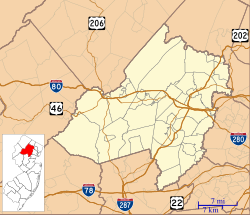First Congregational Church | |
 | |
| Location | 30 Hillside Road Chester Borough, New Jersey |
|---|---|
| Coordinates | 40°47′14″N74°41′45″W / 40.78722°N 74.69583°W |
| Area | 2.3 acres (0.93 ha) |
| Built | 1856 |
| Architectural style | Greek Revival |
| NRHP reference No. | 77000892 [1] |
| NJRHP No. | 2100 [2] |
| Significant dates | |
| Added to NRHP | August 10, 1977 |
| Designated NJRHP | August 2, 1976 |
First Congregational Church is a historic church located at 30 Hillside Road in Chester Borough, New Jersey. The congregation was founded in 1740. [3] The church building was added to the National Register of Historic Places on August 10, 1977, for its significance in architecture, art, and religion. [4]







